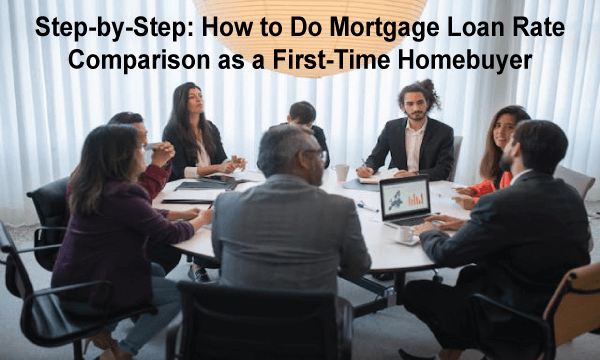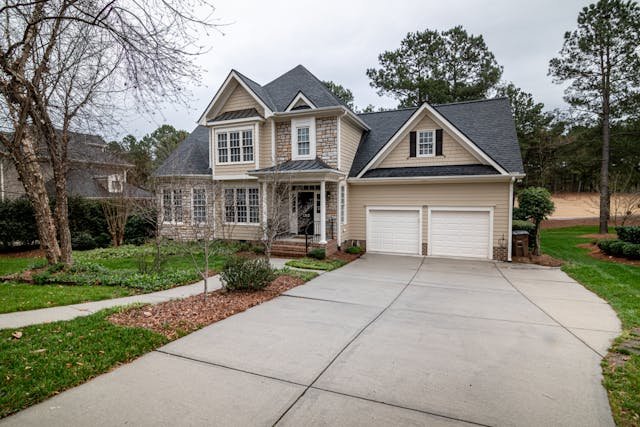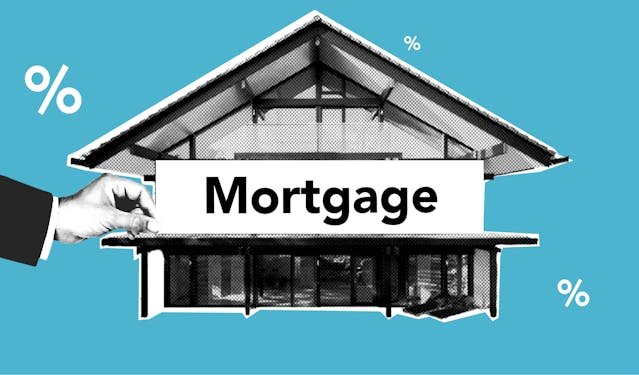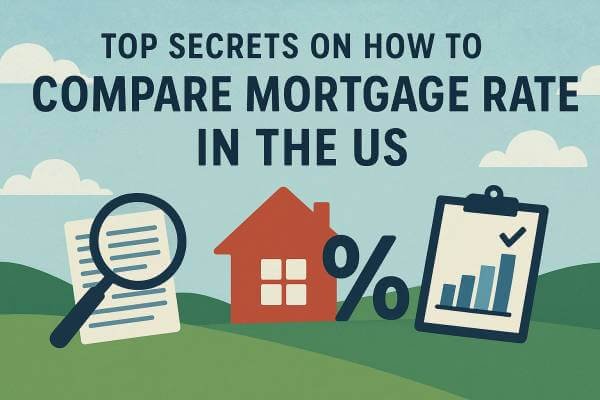Step-by-Step: How to Do Mortgage Loan Rate Comparison as a First-Time Homebuyer

This mortgage loan rate comparison guide is a continuation of what we started as a step-by-step guide on how to compare mortgage loan rates for first-time homebuyers.
You can catch up on steps 1 – 4 by clicking on this link to read more…
Step-by-Step: How to Compare Mortgage Loan Rates as a First-Time Homebuyer
Let’s dive straight into business.
Step 5: Consider Loan Flexibility and Hidden Terms
Alright, you’re becoming a mortgage comparison pro now! But here’s a tip: when doing your mortgage loan rate comparison, rates and fees aren’t everything. Occasionally, the hidden terms or flexibility in a loan can significantly impact the deal. Let’s dig into these often-overlooked details.
Is the Interest Rate Locked or Floating?
A “locked” rate means the lender promises to keep your interest rate fixed until closing—even if market rates rise. A “floating” rate moves up or down until you close your loan.
Ask yourself:
- Does the lender charge fees to lock your rate?
- How long does the lock last (30 days, 60 days)?
- What happens if the lock expires?
When you’re deep into mortgage loan rate comparison, rate locks matter big-time. Locking a low rate can save you significant money if interest rates are rising.
Can You Make Extra Payments or Refinance Early?
Unbelievably, some lenders penalize you for early mortgage repayment. Thats not fair enoughThat’s, right? Always double-check:
- Are there prepayment penalties?
- Are you allowed to make extra payments toward the principal without fees?
- Can you refinance easily later?
If your objective is to acquire your home more quickly or refinance in the future, you should prioritise loan flexibility.
Is there an expiration date for your preapproval?
A pre-approval is awesome—it gives you credibility when making an offer. But remember, it’s not indefinite:
- When does your pre-approval expire (usually 60–90 days)?
- Can the lender easily extend or update it?
Make sure your chosen lender provides a clear timeline to keep your homebuying stress-free.
What If the Appraisal Comes in Low?
Occasionally, the home’s appraisal value comes back lower than the purchase price. This could potentially disrupt your plans. You need to ask:
- Will the lender let you renegotiate or dispute the appraisal?
- What are your options if the appraisal value falls short?
- Does the lender offer flexibility in adjusting loan terms to accommodate the difference?
Knowing these policies upfront helps avoid last-minute panic.
When you conduct your mortgage loan rate comparison, looking beyond the rates to hidden terms and flexibility can be a game-changer. Remember, mortgages aren’t just about getting the lowest rate; they’re about finding the best match for your financial future.
Step 6: Look Beyond the Numbers: Service & Experience
By now, you’ve mastered the art of mortgage loan rate comparison. But here’s something many first-time homebuyers overlook: the lender’s customer service and overall experience. Numbers matter, sure, but having someone supportive, reliable, and responsive on your side makes the entire process smoother and far less stressful.
Let’s talk about how you can evaluate lender reputation and pick a company that truly cares about your success.
Communication: How Responsive Is the Lender?
Ever tried reaching customer support, only to hear endless hold music? Frustrating, right? Imagine dealing with that while trying to close on your dream home.
Ask yourself:
- Does the lender respond quickly and clearly to your emails or calls?
- Do they proactively update you about your loan’s progress?
- Can you easily reach a real human if you have questions?
Trust me, clear communication makes your homebuying journey much easier.
Transparency: Do They Clearly Explain Your Options?
When you’re comparing lenders, transparency is a huge factor. You want someone who:
- Clearly explains each step of the process without complicated jargon.
- Takes the time to ensure you understand your loan options fully.
- Doesn’t hide fees or terms in confusing fine print.
If a lender dodges your questions or seems hesitant to explain things clearly, run in the opposite direction.
Reviews: What Are Other First-Time Buyers Saying?
Real customer reviews can reveal what it’s actually like to work with a lender. Don’t skip this step!
Check out:
- Google reviews
- Zillow ratings
- Better Business Bureau (BBB)
- Trustpilot or Yelp
Search for patterns in feedback. While a few negative reviews may be typical, persistently negative experiences should cause concern.
Local vs. Online Lenders: Which Is Better?
Here’s a big one. Should you pick a local lender or an online lender?
- Local Lenders: Typically more personal and familiar with your area, easier to meet in person, but might have fewer loan options.
- Online Lenders: Often offer competitive rates and streamlined processes but might lack personal interaction or local market knowledge.
When doing your mortgage rate comparison, consider which experience matters most to you: Should you prioritise a personal connection or convenience and speed?
Finding the right lender isn’t just about rates and fees. It’s also about trust, service, and ease of communication. Choose a lender who feels like a partner rather than just a business transaction, and your homebuying experience will be far more rewarding.
Step 7: Ask These 5 Must-Know Questions Before Choosing a Lender
We’re nearly there! At this stage of your mortgage loan rate comparison, you’ve probably narrowed down your choices to a few great lenders. But before you say “yes” and commit, you’ve got to ask a few key questions. Why? This is because the answers you receive can have a significant impact on your financial future.
Here are the five questions you simply cannot skip asking your lender.
1. Are any of these fees non-refundable?
Imagine you pay a fee upfront, and suddenly your loan falls through. You’d lose money before even getting a house.
Ask clearly:
- “Which of these fees are non-refundable if the loan doesn’t close?”
- “Under what circumstances could I lose these fees?”
Knowing this upfront helps you avoid unpleasant surprises.
2. Can you explain what this specific fee is for?
Are you confused by all those random-sounding fees like “origination”, “processing”, or “underwriting”? Don’t just nod and accept them; ask questions!
- “Why am I paying this particular fee?”
- “Is this fee negotiable or necessary?”
A good and trustworthy lender will gladly explain each charge in plain English.
3. What Happens if I Need More Time to Close?
Real estate transactions can be unpredictable. What if your closing gets delayed due to paperwork or inspections?
Make sure to ask:
- “Will you extend my rate lock if closing is delayed?”
- “Are there additional fees if the closing date gets moved back?”
Flexibility here can save you headaches (and money!) later.
4. What’s the most significant difference between your loan offer and competitors’?
This question encourages the lender to openly highlight the best aspects of their offer compared to others you’re considering. It helps you get a clearer picture and can uncover hidden perks or savings you might’ve overlooked.
- “Why should I choose you over other lenders?”
- “Are there benefits or terms you offer that other lenders typically don’t?”
5. What Type of Support Do You Offer After Closing?
Your relationship with a lender doesn’t end once you get the keys; there’s ongoing management of your mortgage to consider:
- “Who do I contact if I have a question about my loan later on?”
- “Do you maintain your loans, or will you sell them to another company?”
Knowing the type of support you’ll receive can make your homeowner journey far smoother.
Asking these key questions before finalizing your lender choice ensures you’re making a smart, fully informed decision. After all, when it comes to choosing the right lender, knowledge truly is power.
Step 8: Choose the Best Mortgage Loan for Your Goals
You’ve gathered all the information, done a thorough comparison of mortgage loan rates, and asked your lenders some crucial questions. Now it’s decision time—choosing the mortgage loan that matches your personal goals and financial situation.
Here’s how you can confidently pick the loan that fits your life perfectly.
Match the Loan to Your Personal Situation
Every first-time buyer is different. So ask yourself:
- How long do you plan to stay in the home?
If it’s less than 5–7 years, an adjustable-rate mortgage might save you money. Planning long-term? A fixed rate might be safer. - What monthly payment truly fits your budget?
Choose a monthly payment that leaves room for savings, emergencies, and life’s unexpected surprises. - How much cash do you have upfront?
If you have limited cash on hand, pick a loan with lower upfront fees or one that accepts a smaller down payment.
Best Loan for Stability vs. Flexibility
Some homebuyers prefer predictable payments, while others prefer flexibility. Consider these options:
- Fixed-Rate Loans: Stable payments every month. These loans are ideal if you have a strong desire for consistency and predictability.
- Adjustable-Rate Loans (ARM): Low initial payments, ideal if you plan to move or refinance after a few years.
When you’ve completed your detailed comparison of mortgage loan rates, choose based on which aligns best with your comfort level and lifestyle.
Lowest Rate Doesn’t Always Mean the Best Deal
Sounds weird, right? But here’s the truth: the loan with the lowest interest rate isn’t automatically the best choice if it comes with high fees or tricky terms.
Always look at the full cost, i.e., interest, fees, closing costs, and monthly payments, then decide which gives you the best overall financial outcome.
Final Checklist Before Signing
Before you say “yes”, double-check this quick list:
- ✔️ Interest Rate and APR: Are they clearly understood?
- ✔️ Loan Terms: Comfortable with the length (15, 20, or 30 years)?
- ✔️ Monthly Payment: Can you pay it without stress?
- ✔️ Closing Costs: Are they fair and clearly explained?
- ✔️ Loan Flexibility: Is there room for extra payments or refinancing?
- ✔️ Lender Reputation: Do you trust their customer service and support?
Step 9: Next Steps After Choosing a Loan
Congrats, you’ve officially selected your mortgage! You’ve navigated the complexities, done an in-depth comparison of mortgage loan rates, and now you’re nearly ready to claim those house keys. But what happens next?
Here’s everything you can expect from now until move-in day.
Locking Your Rate
Remember all that talk about interest rates? Now’s when you officially lock in your rate. This procedure means your lender promises to keep your chosen rate unchanged until you close your loan, even if the market fluctuates.
A quick tip:
- Ask your lender clearly, “How long is my rate locked for?” Typically it’s 30–60 days.
- Confirm whether there are any costs associated with extending the rate lock.
This straightforward step ensures you have a clear understanding of your closing costs.
Final Underwriting Process
This might sound a bit scary, but it’s mostly behind-the-scenes paperwork. Your lender’s underwriting team double-checks everything one last time:
- Income verification
- Credit history
- Debt-to-income ratio
- Appraisal and property details
They may ask for extra documents or clarifications. This is totally normal. The faster you respond, the smoother and quicker the process goes.
Preparing for Closing
You’re almost there! Your lender will send you a Closing Disclosure about three days before closing. This document could be considered your final mortgage “receipt,” outlining your exact loan terms and all closing costs.
Please review these details carefully:
- Check numbers match your loan estimate.
- Confirm there are no unexpected changes in fees, payments, or terms.
If something seems off, ask immediately. This is your last chance to resolve any issues.
Closing Day: What to Expect
Finally, closing day! This ceremony is when you officially sign documents and the home becomes yours.
Here’s what typically happens:
- Bring ID and a cashier’s check or arrange a wire transfer for any remaining down payment and closing costs.
- Expect to spend about an hour signing paperwork.
- You’ll get the keys immediately afterwards; it’s that exciting!
You’ve made it through your mortgage journey. Thanks to your careful comparison of mortgage loan rates, you’re stepping into homeownership prepared and confident.
Before we conclude, let’s quickly review some common mistakes in mortgage comparisons, so you can avoid them and celebrate your success!
Common Mortgage Comparison Mistakes to Avoid
You’ve made significant progress; let’s ensure the process is completed smoothly and without any obstacles. During your mortgage loan rate comparison, it’s easy to overlook certain details. Here are the most common pitfalls first-time homebuyers stumble into (and how you can dodge them).
Only Comparing Interest Rates
Sure, interest rates matter. But if you focus solely on that one number, you’re missing the bigger picture.
Instead, ask yourself:
- How much will the fees and closing costs add up to?
- What’s the APR (the true cost of your loan including fees)?
- Does a slightly higher rate with fewer fees save me money overall?
Always look at the total cost, not just the advertised rate.
Ignoring APR
The Annual Percentage Rate (APR) reflects both interest and loan fees. Ignoring APR is like buying a car without checking for hidden fees; you could end up paying more than expected.
Always use APR to get a clearer sense of your loan’s total cost.
Not Reading the Fine Print
Mortgage paperwork is boring and dense. But skipping the fine print can be a costly mistake.
Always double-check:
- Are there prepayment penalties?
- What happens if you miss a payment?
- Are there hidden fees buried deep in your loan estimate?
Reading thoroughly ensures you’re truly getting the best deal.
Skipping Credit Score Improvement Steps
Did you know a slight improvement in your credit score could drastically lower your interest rate?
Before you finalise your mortgage, always ask yourself:
- Could I improve my credit score quickly?
- Am I applying at the optimal time for the best rates?
Even small improvements can lead to major savings.
Rushing the Decision Due to Urgency
Homebuying can feel urgent, especially if the market’s competitive. But don’t let urgency rush your decision.
Take your time and ask yourself:
- Do I truly understand all the terms?
- Am I confident this is the best loan for me?
- Is the lender responsive, trustworthy, and clear?
If you’re unsure, pause. The right home loan is worth waiting for. Steering clear of these common pitfalls ensures your thorough comparison of mortgage loan rates truly pays off. You’re now equipped to make the best mortgage choice confidently and save thousands along the way.
Conclusion:
Celebrate Your Homebuying Confidence!
You did it! You’ve officially navigated the tricky waters of mortgage loan rate comparison. Now, you’re ready to confidently choose a mortgage that’s perfect for you—not just today, but for years to come.
Buying your first home can feel overwhelming, but by carefully comparing loan rates, terms, and lender reputations, you’ve set yourself up for long-term success. You’re not just buying a house; you’re building your financial future.
So, what’s next?
- Stay organized: Keep track of your loan documents.
- Ask questions: your lender is there to help even after you close.
- Celebrate your milestone: Homeownership is a big deal—enjoy it!
Remember, the more informed you are, the more empowered you’ll feel. If you need to revisit any step or have more questions, come back to this guide anytime.
You’ve got this and soon, you’ll have the keys in your hand to prove it!
Frequently Asked Questions (FAQ)
1. Why should I compare mortgage loan rates before choosing a lender?
Comparing mortgage loan rates helps you find the best deal—not just in interest, but in fees, monthly payments, and total cost over time. Even a small rate difference can save you tens of thousands of dollars over the life of a loan.
2. How many mortgage loan offers should I compare?
Experts recommend getting loan estimates from at least 3 to 5 lenders. This gives you a clearer view of available rates, fees, and loan terms so you can confidently choose the most affordable option.
3. Does shopping for mortgage rates hurt my credit score?
Not if you do it right. Multiple credit checks for mortgage rate shopping within a 30–45 day window typically count as a single inquiry. This procedure allows you to compare offers without damaging your credit.
4. What’s the difference between interest rate and APR?
The interest rate is the cost of borrowing money, while the APR (Annual Percentage Rate) includes that plus lender fees, points, and other costs. APR gives a more complete picture of a loan’s true cost.
5. What fees should I look for when comparing mortgage loans?
Key fees to compare include
- Origination fees
- Discount points
- Application or underwriting fees
- Title and appraisal fees
These vary by lender and can impact your overall loan cost.
6. Are online mortgage lenders better than local banks?
It depends. Online lenders may offer lower rates and faster approvals, while local lenders can provide personalized service and in-depth knowledge of local market conditions. Comparing both types is often the smartest move.
7. Should I choose the lowest rate or the lowest monthly payment?
Choosing the lowest rate or the lowest monthly payment is not always the same thing. A lower rate might come with higher fees, and a lower monthly payment could stretch your loan term, costing more in the long run. It’s best to look at the total loan cost, not just one number.
8. Can I negotiate mortgage rates or fees with lenders?
Yes, absolutely. Many lenders are willing to match or beat competitor offers or waive certain fees to win your business, especially if you have excellent credit and multiple loan estimates.
9. What should I do if two loan offers are nearly identical?
If rates and fees are close, consider other factors like
- Lender reputation
- Responsiveness and customer service
- Rate lock period
- Flexibility with closing timelines
These details can make a big difference in your overall experience.
10. What happens after I choose a mortgage loan?
Once you select a loan, you’ll:
- Lock your interest rate
- Complete the underwriting process
- Receive a Closing Disclosure
- Attend your closing appointment and sign final paperwork.
After that? You get the keys and officially become a homeowner!
Footnotes & Sources
- Freddie Mac—Primary Mortgage Market Survey (PMMS)
https://www.freddiemac.com/pmms
(Weekly data on average U.S. mortgage interest rates and historical rate trends.) - Mortgage Bankers Association (MBA)—Weekly Mortgage Applications Survey
https://www.mba.org/news-research-and-resources/research-and-economics
(National trends on mortgage application volume and rate activity.) - FICO—Average U.S. Credit Score Trends
https://www.fico.com/blogs
(Statistics on consumer credit health and credit score distribution.) - Consumer Financial Protection Bureau (CFPB)—Mortgage Shopping Behavior Study
https://www.consumerfinance.gov/data-research/research-reports/
(Insightful data on how consumers compare mortgage offers and lender transparency.) - National Association of Realtors (NAR)—Profile of Home Buyers and Sellers
https://www.nar.realtor/research-and-statistics
(Comprehensive data on first-time buyer behavior, financing methods, and home search trends.) - U.S. Census Bureau—Homeownership and Housing Statistics
https://www.census.gov/housing/hvs/
(Quarterly stats on homeownership rates and first-time buyer participation.) - Federal Housing Finance Agency (FHFA)—Mortgage Data & House Price Index
https://www.fhfa.gov/DataTools/
(Loan performance metrics and market data on home financing and pricing.) - Urban Institute – Housing Finance at a Glance: Monthly Chartbook
https://www.urban.org/policy-centers/housing-finance-policy-center/projects/housing-finance-glance-monthly-chartbook
(Monthly snapshots of mortgage origination trends and market share by loan type.) - CFPB – Loan Estimate Explainer Tool
https://www.consumerfinance.gov/owning-a-home/loan-estimate/
(Step-by-step breakdown of how to read and compare Loan Estimates.) - U.S. Department of Housing and Urban Development (HUD) – Buying a Home Resources
https://www.hud.gov/buying
(Government-backed programs, loan types, and educational materials for first-time homebuyers.)
























